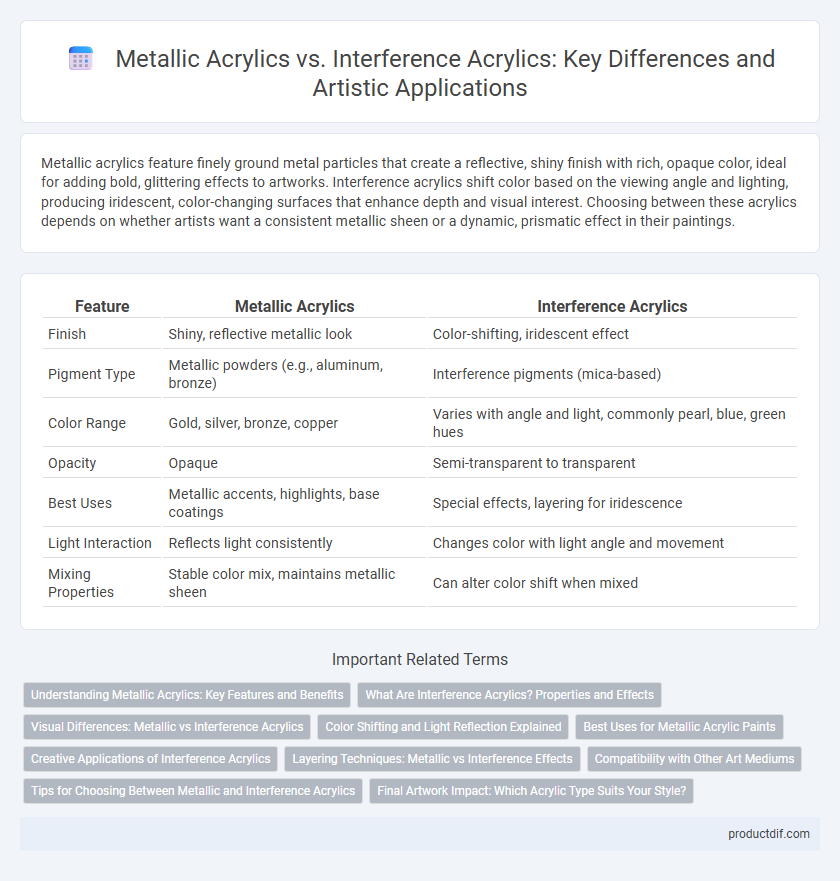Metallic acrylics feature finely ground metal particles that create a reflective, shiny finish with rich, opaque color, ideal for adding bold, glittering effects to artworks. Interference acrylics shift color based on the viewing angle and lighting, producing iridescent, color-changing surfaces that enhance depth and visual interest. Choosing between these acrylics depends on whether artists want a consistent metallic sheen or a dynamic, prismatic effect in their paintings.
Table of Comparison
| Feature | Metallic Acrylics | Interference Acrylics |
|---|---|---|
| Finish | Shiny, reflective metallic look | Color-shifting, iridescent effect |
| Pigment Type | Metallic powders (e.g., aluminum, bronze) | Interference pigments (mica-based) |
| Color Range | Gold, silver, bronze, copper | Varies with angle and light, commonly pearl, blue, green hues |
| Opacity | Opaque | Semi-transparent to transparent |
| Best Uses | Metallic accents, highlights, base coatings | Special effects, layering for iridescence |
| Light Interaction | Reflects light consistently | Changes color with light angle and movement |
| Mixing Properties | Stable color mix, maintains metallic sheen | Can alter color shift when mixed |
Understanding Metallic Acrylics: Key Features and Benefits
Metallic acrylics contain finely ground metallic particles that create a reflective, shimmering finish, enhancing artworks with a rich, luminous quality. These paints offer excellent opacity and durability, making them ideal for layering and mixed media projects. Artists benefit from their vibrant color payoff and versatility on various surfaces, including canvas, wood, and metal.
What Are Interference Acrylics? Properties and Effects
Interference acrylics are specialized paints containing microscopic particles that create color-shifting effects depending on the viewing angle and light source, producing iridescent or pearlescent finishes. These paints exhibit unique optical properties such as translucency combined with vibrant color changes, making them ideal for adding dynamic depth and luminous highlights in artworks. Unlike metallic acrylics, interference acrylics do not contain reflective metal flakes but rely on interference pigments to achieve their shimmering, multidimensional appearance.
Visual Differences: Metallic vs Interference Acrylics
Metallic acrylics create a reflective, shiny surface that mimics the look of metals such as gold, silver, and bronze, producing a uniform shimmer with consistent color. Interference acrylics feature a color-shifting effect that changes hue and intensity depending on the angle of light and viewer perspective, resulting in iridescent or pearlescent finishes. While metallics emphasize solid metallic tones and brightness, interference paints offer dynamic, multi-dimensional visual effects valuable for adding depth and movement to artwork.
Color Shifting and Light Reflection Explained
Metallic acrylics contain fine metal particles that create a shiny, reflective surface with a consistent metallic sheen, enhancing light reflection and producing a vivid, sparkling effect. Interference acrylics feature mica-based pigments that cause color shifting by reflecting light at different angles, resulting in iridescent hues that change with the viewer's perspective. These unique optical properties make metallics ideal for solid metallic finishes, while interference acrylics offer dynamic, shifting colors for more dimensional and captivating artworks.
Best Uses for Metallic Acrylic Paints
Metallic acrylic paints are best used for adding reflective, shimmering effects to artwork, ideal for highlighting textures and creating a sense of depth with their opaque, light-reflective pigments. Artists often apply metallic acrylics on surfaces requiring bold, solid metallic finishes such as canvas, wood, and ceramics to simulate metals like gold, silver, and bronze. Unlike interference acrylics, which shift color based on the viewing angle, metallic acrylics maintain consistent metallic hues, making them perfect for realistic metal textures and decorative accents.
Creative Applications of Interference Acrylics
Interference acrylics reveal shifting colors and iridescent effects that change with light and angle, making them ideal for creating dynamic, multi-dimensional artwork. Artists use interference acrylics to enhance textures, simulate metallic sheens, and evoke a sense of movement in abstract and mixed media projects. Their unique optical properties enable innovative layering techniques that expand creative possibilities beyond traditional metallic acrylics.
Layering Techniques: Metallic vs Interference Effects
Metallic acrylics create rich, reflective layers that enhance texture and depth with a solid metal-like sheen, ideal for bold highlights and dimensional accents. Interference acrylics offer multi-chromatic, color-shifting effects that change hue depending on light angle, perfect for subtle layering and dynamic, iridescent finishes. Combining these acrylics in layering techniques allows artists to achieve intricate contrasts between opaque metallic gleam and transparent interference shimmer.
Compatibility with Other Art Mediums
Metallic acrylics blend seamlessly with watercolors, oils, and pastels, offering artists versatile layering options without compromising texture or color vibrancy. Interference acrylics, known for their shifting iridescent effects, best integrate with other acrylics and mediums like gels and pastes, but may react unpredictably with solvents or oil-based products. Understanding the chemical composition of these paints ensures compatibility and longevity in mixed media artworks.
Tips for Choosing Between Metallic and Interference Acrylics
Choosing between metallic and interference acrylics depends on the desired visual effect and surface interaction; metallic acrylics deliver a rich, reflective sheen mimicking metals like gold or silver, while interference acrylics offer color-shifting hues that change with the viewing angle. Consider the project's lighting conditions and color harmony, as interference paints work best in dynamic light to showcase their iridescence, whereas metallics provide consistent luster under various lighting. Test both on a small area to evaluate dry time, layering compatibility, and final finish, ensuring the chosen acrylic enhances texture and depth for optimal artistic impact.
Final Artwork Impact: Which Acrylic Type Suits Your Style?
Metallic acrylics create a rich, shiny finish with a uniform metallic sheen that enhances bold, reflective surfaces, perfect for artists seeking a classic metal look. Interference acrylics produce color-shifting effects with iridescent hues that change based on light and angle, ideal for dynamic, multidimensional artwork. Choosing between these depends on whether you prefer a consistent metallic shine or a vibrant, shifting color impact in your final piece.
Metallic Acrylics vs Interference Acrylics Infographic

 productdif.com
productdif.com